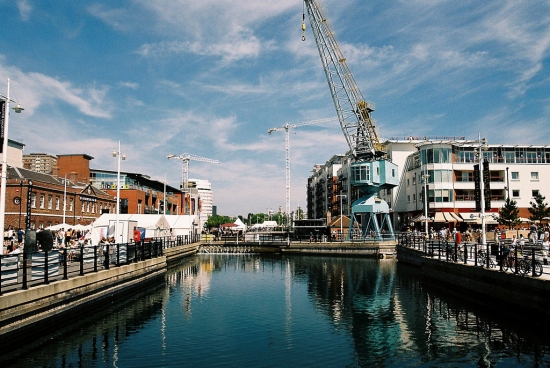Architects are coming up with increasingly inventive ways to not only save space in town centres, but to make these spaces attractive places to be. With the high street only just hanging on to growth and consumers turning to online shopping in their droves the theory is that, by making shopping districts more aesthetically pleasing, more members of the public will be drawn to these areas and thereby choose to spend locally.

Gunwharf Quays
A number of different methods have been tried and tested – for example, we recently reported the unveiling of Europe’s largest living wall on an office block in Birmingham. However, the current favourite design feature seems to be water, with urban planners tripping over themselves to include a fountain or miniature river in their blueprints.
Yet taking water into consideration is not simply a design issue but a necessity according to the Construction Industry Research and Information Association (CIRIA). In their most recent report, entitled Water Sensitive Urban Design in the UK, they say:
“Water shortages, flooding and watercourse pollution are all signs of stress where developed areas have a troubled interaction with the natural water cycle and where, conversely, water has become a risk or a nuisance rather than an asset or an opportunity.”
The report also consults professionals in order to determine their views on the subject. 83 per cent of participants had the view that water management was not factored in to the planning stages of developments early enough – something which they believe should change in order to ensure new builds are safe from flooding.
Unfortunately, the risk of building on low-lying areas became all too clear in 2012, when widespread flooding caused problems for residential and commercial properties alike. Today, according to Defra, a huge 5 million properties are at risk of flooding in England alone despite improvements such as flood barriers and early warning systems being put in place throughout at-risk communities.
This could prove to be a huge problem if the Association of British Insurers decides not to renew their agreement to cover properties in high-risk areas in July of this year.
Perhaps the solution lies in incorporation, as seen at Portsmouth shopping complex Gunwharf Quays. This development has managed to create a structurally secure base on the south coast of England, with views over the Channel and water features allowing for a natural blend of buildings and tidal patterns.
If more developers can make space for water paths in large commercial developments, their tenants will benefit along with the environment.